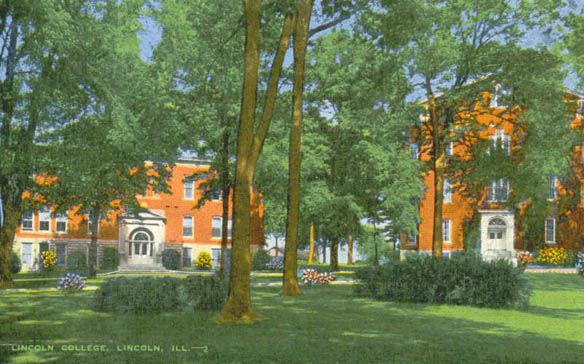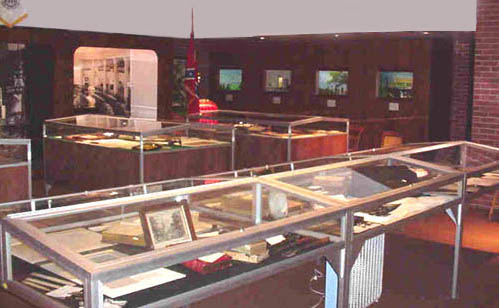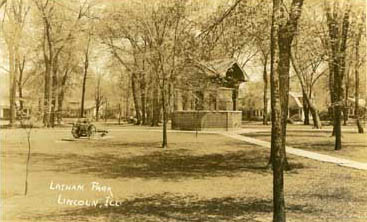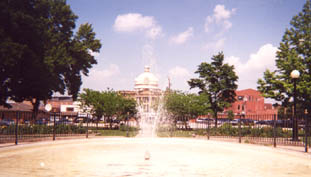
1860 photo taken 4 days after Mr.
Lincoln visited Lincoln, Illinois, for the last time. Info at 3 below.
This President
grew;
His town does too.
Link to Lincoln:
Lincoln & Logan County Development Partnership
Abraham Lincoln Bicentennial Commission of Lincoln, IL
|
Internet Explorer is the only browser that shows this page the way it was designed.
Your computer's settings may alter the display.
April 24, 2004: Awarded "Best Web Site of the Year" by the Illinois State Historical
Society
|
|
|
|
Marquee Lights of the Lincoln Theater, est. 1923, Lincoln, Illinois |
|
|
|
29. Museums and Parks, |
|
Today Lincoln, Illinois, offers
two museums and fourteen parks in and near the city. Three parks have
prairie and woodland features: the Edward R. Madigan State Park (1366
1010th Ave.-- south of Lincoln, just off old Route 66), Kickapoo Creek Park
(2000 North Jefferson, just north of the old Route 66 beltline), and Lincoln
Memorial Park (approximately one mile west of old Route 66 beltline near Salt
Creek). Lincoln Memorial Park occupies the former Chautauqua grounds,
largest Chautauqua site in Illinois. For a complete list of parks, see
the link in Sources Cited to Lincoln Courier's page
titled "Lincoln Area Parks and Recreation Sites"). The Lincoln College Museum Under the leadership of Ron Keller and Paul Gleason, the Lincoln College Museum is growing substantially. Plans are underway for a new facility -- the Lincoln Center -- to accommodate the many holdings that have resulted from numerous acquisitions over more than half a century. The museum's educational and research activities are expanding as well. The creation of a new facility for the Lincoln College Museum builds on the work of its original benefactor, Judge Lawrence B. Stringer. In the early 1940s, the Lincoln College Museum began with a collection of historical materials willed to the college by Judge Stringer. He had graduated from Lincoln College in 1887, and while working locally as an attorney and judge, he pursued a life-long, avid interest in Abraham Lincoln and local history. Information from his extensive Logan County History 1911 has been cited many times in this Web site. The museum's collections include numerous historical documents and artifacts relating to Abraham Lincoln, the Civil War, and local and Illinois history.
29.1: Colorized Postcard of
Lincoln College (1941): The original Lincoln College Museum was housed in the Administration-Chapel Building. Judge Stringer, whose collection of Abraham Lincoln memorabilia established the Lincoln College Museum after his death in 1942, describes the Administration-Chapel Building's construction: "The corner stone of the new Building was informally laid by the Board of Trustees, January 11, 1902. The contract was let to Walker & Hall, contractors, of Danville, Ill. for $20,194. J.M. Deal of Lincoln, Ill., was the supervising architect. The building was completed about March, 1903. The dedication of the new building occurred June 9, 1903, during commencement week" (Logan County History 1911, p. 444). The Administration-Chapel was destroyed by fire January, 1969 (Paul Beaver, Logan County History 1982, p. 86), but much of the museum collection was saved, and the Lincoln College Museum is presently housed in the building shown below.
29.2: McKinstry Library and Present-Day Lincoln College Museum at 300 Keokuk and Ottawa Streets (Leigh Henson photo, 5-02) Plans for New Facility On December 28, 2001, "Governor George H. Ryan announced. . . that he is releasing $1.22 million in Illinois FIRST funding for projects in Central Illinois, including $1 million to Lincoln College, a private, not-for-profit, coeducational, residential junior college in Lincoln, to construct a facility to be called the 'Lincoln Center.' The facility will house an athletic and convocation center and a greatly expanded Lincoln College Museum and will offer increased opportunities for regional and sectional tournaments and competitions and will quadruple the available museum display space. A donation of $4,850,000 is being contributed from individuals, foundations and corporations" (State of Illinois Web site, address below in Works Cited). Museum Curator Ron Keller describes the need for a new facility: "People often ask us if we have enough materials for the additional space. But after they have viewed not only what we presently have on display, but some of the treasures in our vault, the necessity of addition museum space becomes apparent" ("Coming Soon: The Lincoln Center. . . ," The Lincoln Newsletter, p. 1). Present Displays and Recent Acquisitions "Lincoln artifacts on display include a table from the log-cabin home of New Salem schoolmaster Mentor Graham, upon which a young Abe Lincoln studied grammar and surveying; the desk he used in the Illinois legislature; an ivory-handled dinner bell from the Lincolns' Springfield home; and tassels from the covering of his coffin" (Lincoln College Museum brochure). Numerous art works are also contained in the facility.
29.3: Displays in the
Lincoln College Museum |
|
|
In 2000, Attorney John Gehlbach of Lincoln, Illinois, donated rare Abraham Lincoln memorabilia to the Lincoln College Museum. Mr. Gehlbach served on the Lincoln College Board of Trustees for forty-seven years. Most of the items in this donation relate to Lincoln's assassination and consist of letters, photos, commemorative ribbons, mourning cards, and pieces of fabric from Lincoln's coffin. Documents in
this collection include "some first-hand accounts of Lincoln's assassination
by men who were in the audience at Ford's Theatre on the night of April 14,
1865. . . . One very interesting account is a signed document written
by the only man known to have actually taken shorthand notes about what
transpired that night as Lincoln lay dying. . . . Corporal James
Tanner, who had lost both legs on active duty during the war, had learned
shorthand to qualify for a government post." The Gehlbach Collection
is estimated at $76,000. (The Lincoln Newsletter, 19.4, p. 1).
|
29.4: Historians Paul Gleason and Ron Keller Catalog Items in the Gehlbach Collection (Photo from The Lincoln
Newsletter 19.4, p. 1) |
|
29.5:
Lincoln's Desk and Chair from
(Photo from the Lincoln College Museum brochure) |
29.6:
Chair from the Original (Photo from The Lincoln Newsletter, 20.4, winter, 2001, p. 4). |
|
Other acquisitions in the last few years include gifts from Elsie Olin Sang and James T. Hickey. Mrs. Sang and her late husband, Philip D. Sang, were long-time friends and benefactors of Lincoln College. Mrs. Sang's gifts in the late 1990s were a carved crystal vase commemorating Abraham Lincoln and "an autograph manuscript in the hand of Abraham Lincoln, circa 1855, of one of his favorite poems, "Mortality." The vase, which Mr. Sang commissioned in 1950, is the creation of world-renowned artists of J. & L. Lobmeyer of Vienna. The vase, six and on-half inches tall by three and one half inches in diameter, depicts the profile head of Lincoln and the opening lines of the Gettysburg Address" (New Acquisitions at the Lincoln College Museum," The Lincoln Newsletter, 14.3, p. 3). "The gift from the Hickey Family is an antique rifle which belonged to William Hickey, who was James T. Hickey's great grandfather and who accompanied Lord Scully in the time of the land acquisition of the farms in the Logan County area owned by Lord Scully at one time. Lord Scully rode his horse while Mr. Hickey carried the shovel to 'search' for the good soil. Jim Hickey asked that this gun be given to Lincoln College" "New Acquisitions at the Lincoln College Museum, The Lincoln Newsletter, vol. 14, no. 3, fall, 1996, p. 3).
29.7: Logan County
Frontier Rifle from the James Hickey Family |
|
|
"The Hall of Presidents, located just outside the
main museum area, was designed to honor all those who have served in the
position of chief executive of this country. On display are documents
signed by every president and almost every first lady, together with their
pictures and commemorative medals" (Lincoln College Museum brochure).
|
|
|
Expanding Educational and Research Programs
In 2000, Ron Keller was appointed to the Newman Chair History Instructor at
Lincoln College and designated as the curator of the Lincoln College Museum.
This chair is named for Historian Ralph G. Newman, who served for
forty-seven years on the Board of Trustees of Lincoln College. Mr.
Keller and Assistant Museum Curator and Historian Paul Gleason have
aggressively promoted research and educational outreach as central to the
museum's growth and development. |
|
|
Mr. Keller and Mr. Gleason are invigorating museum activities to educate anyone interested in Abraham Lincoln and to generate this interest in public school children, local citizens, and tourists. A living history program has been started for students from local grade and high schools as well as Lincoln College. This program is called T.E.A.M. (Teaching Enrichment at the Museum). Keller and Gleason have devised an "open door" policy with "hands on" teaching and learning activities: "We have and will continue to eagerly invite area students of all ages from kindergarten through high school to use the documents, relics, and holdings that we have in the museum as educational tools. We also have and will continue to create interactive methods to teach, using those mentioned collections in the museum" ("Lincoln College T.E.A.M. Project, p. 6). Specific activities are
adapted to students according to their age. |
29.8: Ron Keller in Period Apparel "Brings History to Life" for Students of Northwest School (Photo from "Ron Keller Has Big Plans for the Lincoln College Museum" in The Lincoln Newsletter, 19.4, winter, 2000, p. 7. Caption of the photo reads, "Nathan Truehart, Kayleh Galvin, Lindsey Walter, and other Northwest students learn about Lincoln history at the Lincoln College Museum from Ron Keller.") |
|
Activities for grade school students include role-playing, reading to students, and taking items from the display cases for "show and tell." Older grade school students are invited to "act out plays about Abraham Lincoln and local history, including dialogue and simple actions. . . " As seen in the photo above, Ron sometimes appears in period dress. One of the characters Ron portrays is John S. Stevens, a boy who witnessed Abraham Lincoln's christening of Lincoln, Illinois, on August 27, 1853. Paul Gleason, author of Lincoln: A Pictorial History and co-author with Paul Beaver of Logan County Pictorial History, talks to students about local history. "For the younger children, Paul frequently arranges a 'Scavenger Hunt' in the Hall of the Presidents. The children search for facts about United States Presidents that they can find in the displays." High school students use the McKinstry Library, including its rare book room, to research historical topics relating to English, history, and social studies, which might involve map work ("Lincoln College T.E.A.M. Project," p. 6). A significant accomplishment in advancing the status of the Lincoln College Museum was the agreement early in 2002 of the Lincoln Group of Illinois to move its resources to the museum. Previously this group had been based at the Benedictine College at Lisle, Illinois. According to Ron Keller, the Lincoln Group "is made up of more than 100 historians from across the nation who are dedicated to Abraham Lincoln research. . . . The Lincoln Group will move its archives to Lincoln College. The group sponsors a journal, regular business meetings, lectures, and presentations and social gatherings at various Lincoln-related events" ("Lincoln Research Group Will Move to College Museum," www.lincolncourier. com, 2-21-02). The Lincoln College Museum is "open Monday - Friday 9-4, Saturday-Sunday 1-4. [It is] closed on holidays, but open Abraham Lincolnís birthday. Admission is free, though donations are welcome. We welcome group tours, but please call in advance for arrangements" (Lincoln College Museum Web site). The Lincoln College Museum publishes The Lincoln Newsletter quarterly. A one-year subscription is $10.00, and a three-year is $25.00. Write to Lincoln College Museum, 300 Keokuk Street, Lincoln, IL 62656.
For the best information about the Lincoln College Museum and the Hall of
Presidents, I strongly recommend that you visit the Museum's Web site (link
in Works Cited below). 217-732-3155 |
|
|
The Heritage-In-Flight Museum
The Heritage-In-Flight Museum, located at the Logan County Airport
(1351 Airport Road, Lincoln, Illinois 62656, phone 217-732-3333), displays military artifacts and
memorabilia of 20th-Century American wars. This Museum, which is open
to the public, occupies a WW
II building from Camp Ellis, Illinois, a large WW II prisoner-of-war camp. |
|
|
29.9: Logan County Airport |
29.10: Heritage-In-Flight Museum |
|
(Above photos by Leigh Henson, 7-02) |
|
|
29.11: Image Reproduced
as Found in Illinois Weekend Adventure Guide, p. 65 |
|
|
|
|
|
29.12: Image of Vought A-7E Corsair II Adapted from Illinois Weekend Adventure Guide, p. 65 The Corsair II seen above is one of several aircraft housed at the Heritage-In-Flight Museum. According to a Web site titled Skytamer Images (Web site address below in Sources Cited), the Heritage- In-Flight Museum has the following aircraft on display in addition to the Corsair II:
∑ Aeronica L-16 In addition, the Skytamer Web site says that the American Veterans Post 263 of Lincoln has a Lockheed T-33A Shooting Star #51-6680. See Works Cited for Web
sites presenting more information about the Heritage-In-Flight Museum.
Additional information is available through the State of Illinois at its
"Enjoy Illinois" Web site (address below in Sources Cited). |
|
|
Parks The original layout of Lincoln included two parks in what is now the business and historic district. These areas were donated to the city by its founding fathers, along with the land for the courthouse and county jail. The two parks, Latham and Scully (the latter, formerly Washington Park), are each a square block and are the property of Logan County. Latham Park is located two blocks northeast of the courthouse, Scully Park two blocks southwest of the courthouse.
The locations of these parks are identified at
14.
Route 66 Map with 51 Sites in
the Business & Courthouse Square Historic District,
Including Locations of Historical Markers
(on the National Register of
Historic Places). |
|
|
Latham Park
29.13:
Centerpiece of Latham Park: (Photo by Stan Stringer, summer 2002) |
|
|
29.14: Undated Picture
Postcard of Latham Park Showing Cannon and Bandstand Stan Stringer's Account of the Latham Park Cannon That Served Both World Wars
29.15: WW l Cannon Also Serving in WW II (Photo from
Gleason, Lincoln: A Pictorial History, p. 191) |
|
|
In November 11, 2002, I emailed the photo of the WW I cannon to 160 Lincoln High alums with the question of why it had disappeared from the park and the community. Stan Stringer emailed his explanation to this group on November 12: "This fall my brother posed Leigh's question as to what happen to the cannon and why to me, but before I tell I'd like to tell how much I enjoyed the cannon as a kid. Nowadays our grandchildren enjoy all sorts of fancy outdoor jungle gyms, etc., for climbing, but I doubt if any are more fun than the old cannon. First, you could pretend to aim it. While the cranking mechanism for adjusting elevation was still there, it had been painted over so it no longer moved. Second, there were seats beside the barrel where two members of the crew could ride while it was being pulled, so you could sit there and pretend you were riding off to battle, and third you could climb all over it just as if it were a jungle gym. The most daring climb was to straddle the barrel and inch out to the end. Finally, once out there you had to make a choice. Either inch back, and be derided by anyone else who had joined you in playing on the cannon, or reach down place your hands in the barrel's mouth and slide off to hang on the end of the barrel then drop. Now to answer Leigh's question. As I understood it, the cannon was brought back after the war from Germany. I'm not sure of this because there certainly were surplus cannons from the US WW I effort and more likely it was simply US surplus. Periodically, throughout the war [WW II] there were scrap metal drives. The scrap metal, etc., were collected in a temporary fenced off part Broadway in front of the courthouse. This didn't interfere with traffic; most people didn't have enough gas for driving, and so the streets had little traffic. During these drives it was amazing to see the things that were found for donation. The metals, aluminum, iron and brass, were needed, but probably most needed was rubber. There was no synthetic rubber then; so old tires and inner tubes were precious. After the war synthetic rubber was used for tires and inner tubes. We sadly discovered strips of synthetic inner tubes failed to have sufficient elasticity for good slingshots. During one of these drives it was determined the town would part with the cannon. I learned of this one day when I saw the cannon in the fenced off area. I certainly had mixed feelings when I saw it. First, it was fitting that the "German" cannon would go to fight the Nazis, but on the other hand I'd miss it, and other kids wouldn't have the fun of climbing it. Adults had no problem with seeing it go to the war effort. So in that way, there seemed to be unanimity that the cannon should go. The last time I saw the cannon someone had placed a souvenir from WW I over the cannon's muzzle. It was a WW I German spiked helmet. Finally, I suspect the city would have had to remove cannon by now anyway. In this litigious society some parent would have sued the city if Johnny got a bruise from a fall."
Respond to Stan at sstringer@cox.net. |
|
|
Scully Park
29.16: Centerpiece of Scully Park: Fountain at Dusk
(Leigh Henson photo, 7-02) |
|
|
29.17:
Scully Park Entrance at Dusk |
29.18:
Fountain with Courthouse in Background |
|
Mementos of
Scully Park in its Former Life as Washington Park
29.19:
Watermelon Rinds in Washington Park in This photo is from the Lincoln Evening Courier, July 31, 1953, p. 8. The quality of the image here is reduced because it is a scan of a printout from microfilm. Here is the Courier caption of the above photo: "THOUGHTLESS INDIVIDUALS who left watermelon rinds lying around Washington Park are going to run afoul of the law if Health Officer Adam Schacht finds their identity. In addition to defacing public property and cluttering up the city park, they are violating a city ordinance which requires all garbage to be placed in a closed container. 'Receptacles are placed in the parks for such trash and are emptied regularly,' said Schacht. 'It's a shame that some careless individuals abuse the privilege of using the city parks.' Requiring garbage to be placed in closed containers and spraying of alleys are measures designed to control flies, and thereby, disease in the city. With the polio season here it is very important that these ordinances be observed, said Schacht. Recreation Dept. Superintendent Bud Baker also reports that whisky bottles and beer cans are frequently left lying about the parks. Since the parks are used as playgrounds for children, this also represents a hazard. One youngster received a severe gash on his foot from a broken whisky bottle in Melrose park recently which was not placed in the receptacle provided for that purpose. Individuals misusing the parks in this manner will face a trip before the police magistrate and a fine if caught, according to Schacht." The above photo suggests that watermelon fever was rampant in Lincoln weeks before the town christening re-enactment on August 29, 1953. Beginning at 3:00 p.m., that ceremony and the subsequent "melon festival" were held at Elm Park near the railroad tracks, where the original ceremony allegedly took place. A Courier article of August 31, 1953, estimated the crowd at 2,000. The re-enactment started the week-long celebration.
29.20: Ad in Lincoln Evening Courier, July 3, 1953, p. 5. Weren't the Fords in the Elks' drawing usually black with black wall tires? One year the Ford was won by a guy who worked at a Sinclair gas station. Wearing his green uniform and cap, he liked to pretend his new Ford was a police squad car, and he enjoyed sitting on Madison Street next to the VFW to scare people driving on Business Route 66 into thinking their speed was clocked by radar. Seems I
recall he was eventually arrested for impersonation of an officer of the
law. Since plea bargaining had not yet been invented, I am unsure if
he is eligible for parole even today. |
|
|
Sources Cited Desk allegedly used by Abraham Lincoln in the state legislature and displayed in the Lincoln College Museum: http://www.lib.niu.edu/ipo/ii010208.html Gleason, Paul E. Lincoln, Illinois: A Pictorial History. St. Louis, MO: G. Bradley Publishing, 1998. Material from Mr. Gleason's books is copyrighted with all rights reserved. Mr. Gleason's material used in this Web site is with permission from the G. Bradley Publishing Company, 461 Des Peres Road, St. Louis, MO 63131. Call 1-800-966-5120 to inquire about purchasing Lincoln: A Pictorial History (1998) (200 pages of rare photos and text) or Logan County Pictorial History (2000) (also 200 pages of rare photos and text). Visit http://gbradleypublishing.com/.
Heritage-In-Flight Museum: information from lincolndailynews.com Heritage-In-Flight Museum Web site: http://www.heritageinflight.org/pages/672032/index.htm Hughett, Barbara. "Coming Soon: The Lincoln College Center to be Built on Lincoln College Campus." The Lincoln Newsletter. 20.3, fall, 2001, pp. 1 and 8. "Lincoln Area Parks and Recreation Sites." Parks of Lincoln and addresses page of the Lincoln Courier: http://www.lincolncourier.com/features/peopleplacethings/parks.asp "Lincoln Assassination Treasures Given to Museum by Trustee John Gehlbach." The Lincoln Newsletter. 19.4, winter, 2000, p. 1. Lincoln College Museum Web site: http://www.lincolncollege.edu/museum/index.htm "Lincoln College T.E.A.M. Project." The Lincoln Newsletter. 19.4, winter, 2000, p. 6. Lincoln Evening Courier. July 31, 1953, p. 8. "Lincoln Research Group Will Move to College Museum." Lincoln Courier online, February 21, 2002. "Museum Acquires Chair from Original Postville Courthouse." The Lincoln Newsletter. 20.4, winter, 2001, p. 4. "New Acquisitions at the Lincoln College Museum." The Lincoln Newsletter. 14.3, fall, 1996, p. 3. Odd Fellows' Museum (online): http://www.ioof-il.org/museum2.htm "Ron Keller Has Big Plans for the Lincoln College Museum." The Lincoln Newsletter. 19.4, winter, 2000, p. 5 and p. 7. Skytamer Images, Air Museum, USA: http://www.skytamer.com/museums/illinois.htm State of Illinois. www.enjoyillinois.com.
The Lincoln College Museum. Brochure published by Lincoln College, 300
Keokuk Street, Lincoln, Illinois, 62656 no date of publication. |
|
Email comments, corrections, questions, or suggestions.
|
|
"The Past Is But the Prelude" |
|
|
|
|





















